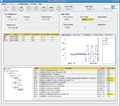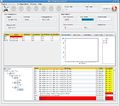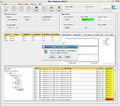Difference between revisions of "Procedure for Operation of CODA Run Control - Fall 2013"
Jump to navigation
Jump to search
| Line 38: | Line 38: | ||
file:codarcerror.jpg |An example of an error condition. Note that it is reported in the center status display as well as the bottom message display. In this example, the event recorder has been disconnected. | file:codarcerror.jpg |An example of an error condition. Note that it is reported in the center status display as well as the bottom message display. In this example, the event recorder has been disconnected. | ||
| − | + | file:codarcpopup.jpg |CODA also features warnings regarding the status of components. Here, the run control suggests a reset after a component (the event recorder) has been unresponsive for a significant amount of time. | |
</gallery> | </gallery> | ||
CODA is an implementation of the Multi-Agent Framework for Experimental Control Systems (AFECS), a Java-based environment for the design and implementation of control systems. AFECS maintains a page with information regarding CODA [https://sites.google.com/site/afecscoda/implementations/coda-run-control here]. The images featured on this page are from the CODA Run Control GUI section of the AFECS page. | CODA is an implementation of the Multi-Agent Framework for Experimental Control Systems (AFECS), a Java-based environment for the design and implementation of control systems. AFECS maintains a page with information regarding CODA [https://sites.google.com/site/afecscoda/implementations/coda-run-control here]. The images featured on this page are from the CODA Run Control GUI section of the AFECS page. | ||
Revision as of 19:53, 26 November 2013
Operation of CODA Run Control
This procedure describes how to initialize a data run using the "simple" configuration, which consists of an Event Builder and a Read-Out Controller. Modification of the set-up can be done through the "dbedit" and "cedit" programs, which allow creation of new configuration files.
- Log on to halld@halldtrg5.phys.uconn.edu. Password is "HallD_DAQ"
- Once into halld, open a terminal, and navigate to the /home/halld/ directory.
- Ensure that the msql daemon is running by typing "msqld".
- Set the proper environment variables by typing "source micro/coda_micro_setup". These environment variables include EXPID and SESSION, which can be changed to accommodate different run control set-ups. You should see the following message:
"Setting up coda 2.6.1 from /usr/local/coda/2.6.1 AFECS Home set to /usr/local/coda/2.6.1/Afecs-1.4 done."
- Once the variables are set, initialize the run control daemon by typing "platform".
- In new terminal windows, start the event builder (EB) by running "home/halld/start_event_builder" and the read-out controller (ROC) by running "home/halld/start_roc".
- Open another terminal window and open the run control interface by typing "rcgui".
- Select "Connect" under the "Platform" menu.
- Click the "Configure" button that appears below the "Platform" menu (farthest to the left) After a moment, the event builder and read-out controller should appear in the table in the center of the gui, as EB5 and TROC5. You should see messages at the bottom indicating that the configure started and has succeeded.
- Click the "Download" button immediately to the right of the "Configure" button. By now, the run parameters Expid, session, and configuration should be displayed.
- Click the "Prestart" button immediately to the right of the "Download" button.
- Click "Start" to begin the run.
CODA is an implementation of the Multi-Agent Framework for Experimental Control Systems (AFECS), a Java-based environment for the design and implementation of control systems. AFECS maintains a page with information regarding CODA here. The images featured on this page are from the CODA Run Control GUI section of the AFECS page.


